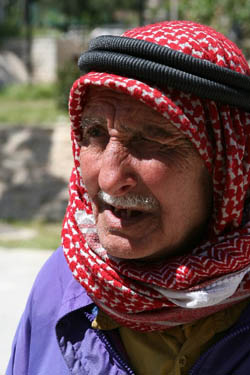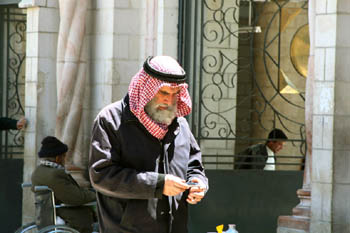

Jordan, day nine (Thursday)
Our driver, Kamese (who we had hired off the street two days earlier), came early for us today. We had said 0900 and he was here at 0830, which was a good thing. We had many plans. Although Kamese spoke almost no English we seemed to communicate well enough.
Our first stop was Madaba, "city of mosaics." We visited a Byzantine Greek orthodox church from the Sixth Century. A large part of the original floor mosaic was intact. It was a mosaic map depicting the hills, valleys, villages and towns as far away as the Nile Delta. It's considered an ancient masterpiece and has two million pieces of colored stone. It is also still a working church. (When we first entered the church a local asked us where we were from and when we said "Texas" he said, "That's why I hang my hat in Tennessee.")
 Next we visited Mt. Nebo, the place of Moses' death and burial (Deuteronomy 34). It was also a place of ancient ruins going back to Paleolithic times. The view from Mt. Nebo was incredible. One is supposed to be able to see the rooftops of Jerusalem and Bethlehem but it was windy and there was a fine silt in the air misting our view. There was a gorgeous Byzantine church there, parts of it still being excavated. It is also a working church with pews. And, there was also an archeological museum full of artifacts.
Next we visited Mt. Nebo, the place of Moses' death and burial (Deuteronomy 34). It was also a place of ancient ruins going back to Paleolithic times. The view from Mt. Nebo was incredible. One is supposed to be able to see the rooftops of Jerusalem and Bethlehem but it was windy and there was a fine silt in the air misting our view. There was a gorgeous Byzantine church there, parts of it still being excavated. It is also a working church with pews. And, there was also an archeological museum full of artifacts.
We went from the mountain top down to the Dead Sea, the lowest place on earth, believed to be the Biblical site of Sodom and Gomorrah. On the way there, at least every two miles there was a check point and soldiers with machine guns—the Dead Sea separates Jordan from Israel. The soldiers only actually talked to Kamese but at one station they wanted to see our passports and I didn't bring mine. They were cool with the Texas driver's license but for a split second I thought I was in trouble with a man with a machine gun.
We changed into shorts and t-shirt and went down into the Dead Sea. It certainly is true that you cannot drown. We floated in only about a foot of water. The water looked about like any water but it felt silky. When I showered I forgot to wash my hair, I guess because it was already wet. Later on, my gooky hair started dripping salt and salt was caked in my ears.
After our salty adventure we ate in the only restaurant in miles. It was a touristy place and much more expensive than usual but the food was local and good. We paid for Kamese as well and it was good to share the meal together.
After our salty adventure we went out of our way to see Lot's cave. We were surprised this was not on the touristy route. There was no one there but a guard and a "closed for renovation" sign. Kamese did some fast talking and we were allowed to go on through. It was a steep, bumpy, gravel road ride and it seemed like the car may not make it and when we got as far as we could by car we then had to climb hundred's of steep steps. But it was worth it. There indeed was a cave with evidence of ancient habitation and outside of it were ruins of a small village. Kamese said he had never been here and that Jordanians do not go here (he may have meant Muslims). However, he stopped before entering the cave and held his hands as if giving an offering and said a little prayer. I also paused for a moment in meditation of the awesomeness of this whole journey. It is here that Lot and his daughters are believed to have sought refuge after God destroyed Sodom, according to Genesis 19.
 Our last big stop was at Karak Castle, also known as the Crusader Castle. It was a massive fortress and had what seemed like miles of tunnels and layers of different buildings and lookout points. We came across another American and she looked concerned because she couldn't find her way out. It was then we realized we were lost too. But we figured it out. Carla's famous words: "Well, it sure is bigger than the Alamo."
Our last big stop was at Karak Castle, also known as the Crusader Castle. It was a massive fortress and had what seemed like miles of tunnels and layers of different buildings and lookout points. We came across another American and she looked concerned because she couldn't find her way out. It was then we realized we were lost too. But we figured it out. Carla's famous words: "Well, it sure is bigger than the Alamo."
From Karak we high-tailed it on home, about a 2.5 hour drive. All along the whole trip we saw the odd camel here and there, Bedouin tents scattered about, goat herds and goat herders and mountains of sand everywhere.
Tomorrow we go to Jerash, Umm Qays, Umm Al-Jimal and the Syrian border. If we're lucky they may give us a visa (though I hear that when do, it takes eights hours of waiting) and then we can see Damascus. If we get in we will spend at least one night there.






















